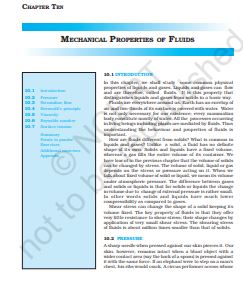‘NCERT Solutions for Class 11 Physics Chapter 10‘ PDF Quick download link is given at the bottom of this article. You can see the PDF demo, size of the PDF, page numbers, and direct download Free PDF of ‘Ncert Class 11 Physics Chapter 10 Exercise Solution’ using the download button.
NCERT Class 11 Physics Textbook Chapter 10 With Answer PDF Free Download

Chapter 10: Mechanical Properties in Liquids
Fluids like liquids and gases are unlike solids in their ability to flow. This distinguishing trait allows them to change shape based on the container they occupy. Understanding how fluids behave compared to solids provides useful insight.
A key contrast is that solids have a definite shape while fluids conform to their containers. Solids, liquids, and gases do have defined volumes at set pressures. However, gases can compress significantly more than solids or liquids under pressure changes.
While solids resist shape change under shear stress, fluids yield readily, almost a million times less forcibly. Density measures this resistance precisely through concepts like viscosity.
The impact of any force relates to both its magnitude and concentrated area. Concentrating force over smaller zones increases its influence dramatically. This focuses power into pressure.
Objects submerged in resting fluids specifically experience forces orthogonally to their surface. Parallel force components would displace liquid laterally. However, resting fluids cannot flow sideways under force. Hence only forces acting normally on submerged surfaces persist according to Newton’s third law.
Analyzing pressure in fluids requires determining how concentration and direction of forces on substructures like vessel walls or impinged objects. Mastering pressure facilitates immense applications from hydraulic machines to circulation.
| Author | NCERT |
| Language | English |
| No. of Pages | 28 |
| PDF Size | 2.1 MB |
| Category | Physics |
| Source/Credits | ncert.nic.in |
NCERT Solutions Class 11 Physics Chapter 10 Mechanical Properties in Liquids
Mechanical Properties in Liquids Textbook With Solutions PDF Free Download
